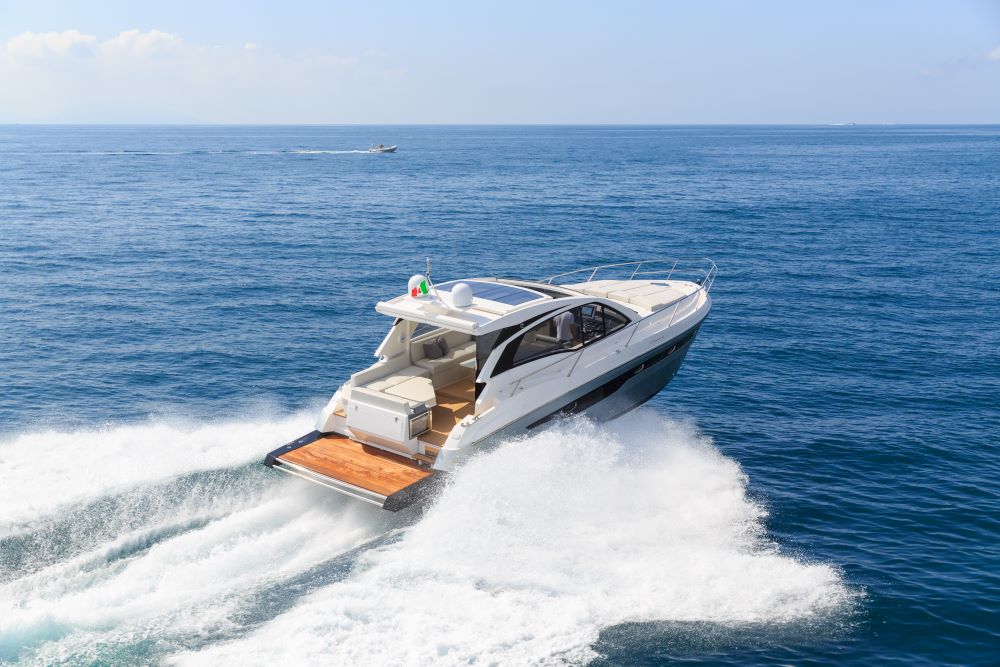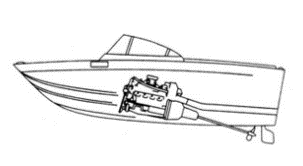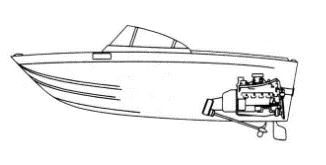
How Do Inboard Boat Engines Work?
If you’re considering getting a motorboat to spend your summer on the water, you probably already know that there are a few different types of engines to choose from.
Some motorboats have outboard engines, while others are equipped with inboard engines. Each type has its own advantages and disadvantages and is suited for different boating activities.
In this article, find out more about inboard engines.
What is an inboard engine?
Unlike outboard engines, which are mounted on the outside of a boat (usually at the stern), inboard engines are installed inside the hull, either in the bilge or in an engine room for larger vessels.
While outboard engines are used to power and steer the boat, inboard engines require one or more rudders for steering, located behind the propeller that drives the boat. When turning, an inboard engine will not pivot like an outboard engine does. Therefore, a boat with an inboard engine will always be steered with a wheel rather than a tiller.
Boat propulsion with inboard engines
Generally speaking, inboard engines are four-stroke engines (much like car engines) that power a drive shaft running through the bottom of the hull. The drive shaft is connected to a propeller that spins to propel the boat. The faster the propeller spins, the more the boat will accelerate.
Types of inboard engines
Inboard engines are always installed inside the boat. There are a few different types of inboard engines—the main ones are direct-drive (D-drive) and V-drive.
Direct drive (D-drive) inboard engines
Direct drive inboard engines are fairly common propulsion systems. In D-drive systems, the engine faces aft and is connected to a drive shaft that protrudes out the bottom of the boat. The drive shaft is a straight rod with a propeller at the end that drives the boat.
This type of drive minimizes engine power loss, and its simplicity makes it highly reliable. However, direct drive inboard engines may need to be placed further forward in the boat, reducing the amount of space available for the cabin and seating.
V-drive inboard engines
Unlike direct drive, a V-drive inboard engine faces forward and has a transmission that redirects the drive shaft towards the stern, creating a V shape. The drive train at the bottom of the boat is similar to a D-drive inboard system, with a shaft connecting to a propeller.
This configuration often provides more space in the cabin or additional seating, because the engine is placed further back in the boat. Unfortunately, some efficiency is lost between the engine and the propeller due to the change in direction.
Other types of inboard engines
There are other types of engines that can also be considered inboard engines.
Hydro-jet engines, which are commonly found on jet-skis and small speedboats, use a turbine instead of a propeller.
There are also Z-drive engines, which are a sort of inboard/outboard hybrid. Rather than having a fixed propeller and rudder, the engine block inside the hull is connected to a base plate similar to an outboard engine. The base plate is equipped with one or two propellers. When turning, the base plate will pivot, guiding the boat in the desired direction.
Why opt for an inboard boat engine?
Inboard engines are very popular with boaters who enjoy water sports. They create great wakes for waterskiing and wakeboarding. Some boat models designed specifically for wakeboarding even come with ballast to create different types of waves.
The propeller is located under a platform at the stern, which is safer for people being towed behind the boat.
Many boaters also appreciate the fact that inboard engines are quieter than outboard ones.
Additional information about inboard engines
Are you convinced that you want a boat with an inboard engine? Here’s some more information to help you make an informed choice.
Cost
Inboard engine boats are generally more expensive than boats with outboard engines.
They can also cost more to insure.
Weight and size
Inboard engine boats are generally larger and heavier than boats with outboard engines, making them more difficult to transport.
They also require more storage space.
Maintenance
Because inboard engines are generally located in the bilge, water, moisture and steam can damage them when you open them up for maintenance. Their location also makes them more difficult to access, particularly compared to outboard engines, whose mechanical components are very easy to access.
Nonetheless, maintenance is essential, because mechanical problems can potentially cause an engine fire that could spread throughout the boat due to the position of the engine. That’s why it’s important to have all the required safety equipment on board.
Operation
Due to their configuration, inboard engine boats are more difficult to dock.
NBSS: Combining boating safety, pleasure and compliance
We hope this article has helped you learn more about inboard engines and how they work.
Remember that in order to comply with Canadian boating laws and regulations, you need to have your Pleasure Craft Operator Card with you at all times. Get your boating license today if you haven’t already, and don’t hesitate to get your family and friends involved and make the most of our group discounts!
If you are looking for boating safety tips, the National Boating Safety School is your best resource. Our boater safety course is a great tool for new boaters before taking the online boating license exam!



